Novel Exertion of Intelligent Static Compensator Based Smart Inverters for Ancillary Services in a Distribution Utility Network-Review
Abstract
1. Introduction
2. Efficacy of Smart Inverters
General Hardware Structure of Smart Inverters
3. Basic Principle of Operation of Smart Inverters
- (a)
- Full PV/Real power mode: The PV–smart inverter STATCOM system generates only real power and zero reactive power. It can also be referred to as the smart inverter working at a unity power factor mode when interfaced with the grid. This is similar to the operation of conventional PV system.
- (b)
- Shared smart inverter mode: The capacity of the inverter is shared for real and reactive power exchange. The PV–STATCOM supplies real power and the remaining capacity are utilized for reactive power control.
- (c)
- Full STATCOM/VAR mode: The entire capacity of the inverter is used exclusively for reactive power injection and absorption. In other words, a novel controller is effectively exercised in the smart inverter mode for injecting/absorbing VAR at full capacity of the inverter for ancillary services during capacitive/inductive modes, respectively are shown in Figure 7.
4. Basic Controller Concept of Reactive Power Compensation Associated with Smart Inverters
4.1. PWM Based Control Strategy Based on dqo Theory
4.2. Hysteresis Based Current Controlled Modulation Technique or Bang–Bang Control
4.3. Fuzzy Based Hybrid Control for Smart Inverters
- (i)
- Volt/VAR control mode: This mode purely represents the regulation of AC voltage by controlling the VAR that is exchanged with the system (injection or absorption). The Volt/VAR control mode has a droop-based Volt/VAR curve as shown in Figure 12.It could be seen from Figure 12 that the smart inverter could be made to operate in one of the operating regions. (a) Linear region with reactive power injection (capacitive) (region between points (V1,Q1) and (V2,Q2)) (b) Linear region with reactive power absorption (inductive) (Region between points (V3,Q3) and (V4,Q4)) (c) Dead band region with zero reactive power injection/absorption (Region between points (V2,Q2) and (V3,Q3)) (d) Saturation region with constant reactive power injection (Region after (V1,Q1)) (e) Saturation region with constant reactive power absorption (Region after (V4,Q4)). A smart inverter based on its control strategy could be made to operate in one of those regions according to the characteristics and requirements of a distribution feeder. The curve can be configured with or without a dead band region based on the required voltage level and reactive power consumption. The slope of linear region of the curve can be decided based on the required reactive power to mitigate the voltage rise caused by active power feed-in of PV systems.
- (ii)
- Volt/watt control mode: This mode represents the regulation of active power that is being exchanged with the system (injection and absorption).
- (iii)
- Low- zero/high voltage ride through (LVRT-ZVRT/HVRT): This mode presents the ability of inverter to stay connected without having to disconnect from the system during faults by means of VAR support from the inverter. There is a tendency that the voltage deviations propagate from the transmission levels to the distribution levels which in turn results in tripping of the DERs connected. During such an event, the smart inverters can provide reactive support without having to disconnect from the system.
- (iv)
- Dynamic reactive current injection: The injection and absorption of reactive current of the inverter forms the basis of dynamic reactive current injection mode. The dynamic variations in the system voltage such as voltage flicker, voltage support during LVRT/ZVRT, require a suitable reactive compensation. Such compensation could be provided by means of dynamic reactive current injection from the inverters of DERs when they are dormant, by making use of its available capacity for such ancillary services. In case of a situation when the inverters are fully utilized for injecting active power, certain amount of real power could be curtailed for using making use of the inverter for reactive current injection. The controller that is associated with the smart inverter employed in Figure 9 utilizes such dynamic current injection technique. Both the active and reactive currents could be controlled separately. This is utilized in conjunction with other steady state reactive power controls. The operating modes during dynamic current injection are shown in Figure 13. The slope of the curve determines the magnitude of capacitive or inductive reactive current injected for a particular voltage deviation.
5. Multilevel Hybrid Smart Inverter Based on Topology
6. Functions of Smart Inverters
7. Coordinated Control of Smart Inverter with the Distribution System
8. Conclusions
9. Future Scope
Author Contributions
Funding
Conflicts of Interest
References
- Rangarajan, S.S.; Collins, E.R.; Fox, J.C.; Kothari, D.P. A Survey on Global PV Interconnection Standards. In Proceedings of the IEEE Power and Energy Conference at Illinois (PECI), Champaign, IL, USA, 23–24 February 2017. [Google Scholar]
- Rangarajan, S.S.; Collins, E.R.; Fox, J.C.; Kothari, D.P. Consolidated compendium of PV interconnection standards across the globe in a smart grid environment. J. Energy Technol. Res. 2018, 2, 1–29. [Google Scholar] [CrossRef]
- Varma, R.K.; Rangarajan, S.S.; Axente, I.; Sharma, V. Novel application of a PV solar plant as STATCOM during night and day in a distribution utility network. In Proceedings of the 2011 IEEE/PES Power Systems Conference and Exposition, Phoenix, AZ, USA, 20–23 March 2011; pp. 1–8. [Google Scholar]
- Rangarajan, S.S.; Collins, E.R.; Fox, J.C. Harmonic resonance repercussions of PV and associated distributed generators on distribution systems. In Proceedings of the 2017 IEEE North American Power Symposium (NAPS), Morgantown, WV, USA, 17–19 September 2017; pp. 1–6. [Google Scholar]
- Rangarajan, S.S.; Collins, E.R.; Fox, J.C. Interactive impacts of elements of distribution systems on network harmonic resonances. In Proceedings of the 6th IEEE International conference on renewable energy research and applications (ICRERA), San Diego, CA, USA, 5–8 November 2017. [Google Scholar]
- Rangarajan, S.S.; Collins, E.R.; Fox, J.C. Detuning of harmonic resonant modes in accordance with IEEE 519 Standard in an exemplary North American Distribution System with PV and Wind. In Proceedings of the 6th IEEE International conference on renewable energy research and applications, San Diego, CA, USA, 5–8 November 2017. [Google Scholar]
- Rangarajan, S.S.; Collins, E.R.; Fox, J.C. Comparative Impact Assessment of filter elements associated with PWM and Hysteresis controlled PV on network harmonic resonance in distribution systems. In Proceedings of the 6th IEEE International conference on renewable energy research and applications, San Diego, CA, USA, 5–8 November 2017. [Google Scholar]
- Rangarajan, S.S.; Collins, E.R.; Fox, J.C. Smart PV and SmartPark Inverters as suppressors of Temporary Over-Voltage (TOV) phenomenon in distribution systems. IET Gener. Transm. Distrib. J. 2018, 12, 5909–5917. [Google Scholar]
- Rangarajan, S.S.; Collins, E.R.; Fox, J.C. Efficacy of Smart PV inverter as a virtual detuner in mitigating network harmonic resonances. Elsevier Electr. Power Syst. Res. J. 2019, 171, 175–184. [Google Scholar]
- Rangarajan, S.S. Efficacy of Smart PV Inverter as a Strategic Mitigator of Network Harmonic Resonance and a Suppressor of Temporary Overvoltage Phenomenon in Distribution Systems. All Diss. 2018, 2235. Available online: https://tigerprints.clemson.edu/all_dissertations/2235 (accessed on 25 March 2020).
- Rangarajan, S.S.; Sreejith, S.; Nigam, S. Effect of distributed generation on line losses and Network Resonances. In Proceedings of the 2014 International Conference on Advances in Electrical Engineering (ICAEE), Vellore, India, 9–11 January 2014; pp. 1–6. [Google Scholar]
- Rangarajan, S.S.; Sreejith, S. Novel 24 hour usage of a PV Solar Farm for reducing Line Loss. In Proceedings of the 2013 International Conference on Energy Efficient Technologies for Sustainability, Nagercoil, India, 10–12 April 2013; pp. 381–386. [Google Scholar]
- Rangarajan, S.S.; Sreejith, S.; Sabberwal, S.P. Cost estimation and recovery analysis of a PV Solar farm utilized round the clock. In Proceedings of the 2013 IEEE Global Humanitarian Technology Conference: South Asia Satellite (GHTC-SAS), Trivandrum, India, 23–24 August 2013; pp. 286–291. [Google Scholar]
- Mozumder, S.; Dhar, A.; Rangarajan, S.S.; Karthikeyan, S.P. Coordinated operation of multiple inverter based renewable distributed generators as an active power injector and reactive power compensator. In Proceedings of the 2014 International Conference on Computation of Power, Energy, Information and Communication (ICCPEIC), Chennai, India, 16–17 April 2014; pp. 298–303. [Google Scholar]
- Berge, J.; Rangarajan, S.S.; Varma, R.K.; Litzenberger, W.H. Bibliography of FACTS 2009–2010: Part IV IEEE working group report. In Proceedings of the 2011 IEEE Power and Energy Society General Meeting, Detroit, MI, USA, 24–28 July 2011; pp. 1–10. [Google Scholar]
- Berge, J.; Rangarajan, S.; Varma, K.; Litzenberger, H. Bibliography of FACTS 2009-2010: Part III, IEEE Working Group Report. In Proceedings of the 2011 IEEE Power and Energy Society General Meeting, Detroit, MI, USA, 24–28 July 2011. [Google Scholar]
- Adekol, O.I.; Almaktoof, A.M.; Raji, A.K. Design of a Smart Inverter System for Photovoltaic Systems Application. In Proceedings of the 2016 International Conference on the Industrial and Commercial Use of Energy (ICUE), Cape Town, South Africa, 16–17 August 2016; pp. 310–317. [Google Scholar]
- Exhibition, I.; Management, E.; Version, D. Smart Inverters for Utility and Industry Applications. In Proceedings of the PCIM Europe 2015; International Exhibition and Conference for Power Electronics, Intelligent Motion, Renewable Energy and Energy Management, Nuremberg, Germany, 19–20 May 2015. [Google Scholar]
- Li, H.; Wen, C.; Chao, K.; Li, L. Research on Inverter Integrated Reactive Power Control Strategy in the Grid-Connected PV Systems. Energies 2017, 10, 912. [Google Scholar] [CrossRef]
- Majumder, R. Reactive Power Compensation in Single-Phase Operation of Microgrid. IEEE Trans. Ind. Electron. 2013, 60, 1403–1414. [Google Scholar] [CrossRef]
- Bolognani, S.; Zampieri, S. A Distributed Control Strategy for Reactive Power Compensation in Smart Microgrids. IEEE Trans. Autom. Control 2013, 58, 2818–2833. [Google Scholar] [CrossRef]
- Valenzuela, C.; Vela, P.; Espinoza, J. Smart Grid Connected Inverter Using a Residential PV System. In Proceedings of the IECON 2017—43rd Annual Conference of the IEEE Industrial Electronics Society, Beijing, China, 29 October–1 November 2017. [Google Scholar]
- Fan, Z.; Liu, X. Smart Inverter with Active Power Control and Reactive Power Compensation. J. Electr. Electron. Eng. 2015, 3, 139–145. [Google Scholar] [CrossRef]
- Hsieh, S.; Lee, Y.; Chang, Y. Applied sciences Economic Evaluation of Smart PV Inverters with a Three-Operation-Phase Watt-Var Control Scheme for Enhancing PV Penetration in Distribution Systems in Taiwan. Appl. Sci. 2018, 8, 995. [Google Scholar] [CrossRef]
- Noyal, M.A.; Ananthi, D.A.; Raja, C. Modified hybrid multilevel inverter with reduced number of switches for PV application with smart IoT system. J. Ambient Intell. Humaniz. Comput. 2018, 1–13. [Google Scholar] [CrossRef]
- Liu, J.; Wu, J.; Zeng, J.; Guo, H. A Novel Nine-Level Inverter Employing One Voltage Source and Reduced Components as High Frequency AC Power Source. IEEE Trans. Power Electron. 2016, 8993, 1–9. [Google Scholar] [CrossRef]
- Babaei, E.; Gowgani, S.S. Hybrid multilevel inverter using switched capacitor units. IEEE Trans. Ind. Electron 2014, 61, 4614–4621. [Google Scholar] [CrossRef]
- Hemachandu, P.; Reddy, V.C.V.; Reddy, V.C.J.M.; Reddy, V.U. A PV/FC Co-Generation Based Micro-Grid System Using Compact Integrated 7-Level Inverter. In Proceedings of the Conference on Power, Control, Communication and Computational Technologies for Sustainable Growth (PCCCTSG), Kurnool, India, 11–12 December 2015; pp. 252–258. [Google Scholar]
- Sunddararaj, S.P.; Srinivasarangan Rangarajan, S.; N, S. An Extensive Review of Multilevel Inverters Based on Their Multifaceted Structural Configuration, Triggering Methods and Applications. Electronics 2020, 9, 433. [Google Scholar] [CrossRef]
- Gupta, K.K.; Jain, S. A Novel Multilevel inverter based on switched DC sources. IEEE Trans. Ind. Electron. 2014, 61, 3269–3278. [Google Scholar] [CrossRef]
- Poyyamani Sunddararaj, S.; S. Rangarajan, S.; Gopalan, S. Neoteric Fuzzy control stratagem and design of Chopper fed Multilevel Inverter for enhanced Voltage Output involving Plug-In Electric Vehicle (PEV) applications. Electronics 2019, 8, 1092. [Google Scholar] [CrossRef]
- Chen, C.; Member, S.; Hsu, C. Coordination of Transformer On-Load Tap Changer and PV Smart Inverters for Voltage Control of Distribution Feeders. IEEE Trans. Ind. Appl. 2019, 55, 256–264. [Google Scholar]
- Juamperez, M.; Yang, G. Voltage regulation in LV grids by coordinated volt-var control strategies. J. Mod. Power Syst. Clean Energy 2014, 2, 319–328. [Google Scholar] [CrossRef]
- Jie, B.; Tsuji, T.; Uchida, K. Coordinated Voltage Control by Inverters and FACTS Devices in Distribution System. In Proceedings of the 2018 China International Conference on Electricity Distribution (CICED), Tianjin, China, 17–19 September 2018; pp. 1872–1875. [Google Scholar]
- Hingorani, N.G.; Gyugyi, L. Understanding FACTS; IEEE Press: Piscataway, NJ, USA, 2000. [Google Scholar]
- Rangarajan, S.S.; Sharma, J.; Kothari, D.P.; Senjyu, T. Novel utilization of Phasor Measurement Units (PMU) in Smart Grid Restoration: A brief survey. In Proceedings of the International Conference on ‘Emerging Trends for Smart Grid Automation and Industry 4.0’ ICETSGAI4.0, Ranchi, India, 5–9 December 2019. [Google Scholar]
- Swaminathan, G.; Rangarajan, S.S.; Sharma, J.; Kothari, D.P.; Senjyu, T. Techno-economic Benefits of Grid Penetrated 1 MW PV System in India. In Proceedings of the International Conference on ‘Emerging Trends for Smart Grid Automation and Industry 4.0’ ICETSGAI 4.0 2019, Ranchi, India, 5–9 December 2019. [Google Scholar]
- Sharma, J.; Rangarajan, S.S.; Sundarabalan, C.K.; Karthikaikannan, D.; Srinath, N.S.; Kothari, D.P.; Senjyu, T. Synergistic damping operation of TCSC & CPSS using PSO in a power system. In Proceedings of the International Conference on ‘Emerging Trends for Smart Grid Automation and Industry 4.0’ ICETSGAI4.0 2019, Ranchi, India, 5–9 December 2019. [Google Scholar]
- Sharma, J.; Rangarajan, S.S.; Srikanth, V.S.S.; Sundarabalan, C.K.; Kothari, D.P.; Senjyu, T. Transient Stability Enhancement using FACTS Devices in a Distribution System involving Distributed Generation Systems. In Proceedings of the International Conference on ‘Emerging Trends for Smart Grid Automation and Industry 4.0’ ICETSGAI4.0 2019, Ranchi, India, 5–9 December 2019. [Google Scholar]
- Montenegro, D.; Bello, M.; York, B.; Smith, J. Utilising observability analysis to cluster smart inverters on secondary circuits for residential deployment. Cired Open Access Proc. J. 2017, 2017, 2572–2575. [Google Scholar] [CrossRef][Green Version]
- Rafi, F.H.M.; Hossain, M.J.; Town, G.; Lu, J. Smart Voltage-Source Inverters with a Novel Approach to Enhance Neutral-Current Compensation. IEEE Trans. Ind. Electron. 2019, 66, 3518–3529. [Google Scholar] [CrossRef]
- Malekpour, A.R.; Pahwa, A. A Dynamic Operational Scheme for Residential PV Smart Inverters. IEEE Trans. Smart Grid 2017, 8, 2258–2267. [Google Scholar] [CrossRef]
- Singh, S.A.; Carli, G.; Azeez, N.A.; Williamson, S.S. Modeling, Design, Control, and Implementation of a Modified Z-Source Integrated PV/Grid/EV DC Charger/Inverter. IEEE Trans. Ind. Electron. 2018, 65, 5213–5220. [Google Scholar] [CrossRef]
- Li, S.; Sun, Y.; Ramezani, M.; Xiao, Y. Artificial Neural Networks for Volt/VAR Control of DER Inverters at the Grid Edge. IEEE Trans. Smart Grid 2019, 10, 5564–5573. [Google Scholar] [CrossRef]
- Artale, G.; Cataliotti, A.; Cosentino, V.; Di Cara, D.; Guaiana, S.; Nuccio, S.; Panzavecchia, N.; Tinè, G. Smart Interface Devices for Distributed Generation in Smart Grids: The Case of Islanding. IEEE Sens. J. 2017, 17, 7803–7811. [Google Scholar] [CrossRef]
- Teng, J.; Liao, S.; Huang, W.; Chiang, C. Smart Control Strategy for Conversion Efficiency Enhancement of Parallel Inverters at Light Loads. IEEE Trans. Ind. Electron. 2016, 63, 7586–7596. [Google Scholar] [CrossRef]
- Spring, A.; Wirth, G.; Becker, G.; Pardatscher, R.; Witzmann, R. Grid Influences From Reactive Power Flow of Photovoltaic Inverters With a Power Factor Specification of One. IEEE Trans. Smart Grid 2016, 7, 1222–1229. [Google Scholar] [CrossRef]
- Shuvra, M.A.; Chowdhury, B. Distributed dynamic grid support using smart PV inverters during unbalanced grid faults. IET Renew. Power Gener. 2019, 13, 598–608. [Google Scholar] [CrossRef]
- Ebrahimi, M.; Khajehoddin, S.A.; Karimi-Ghartemani, M. Fast and Robust Single-Phase DQ Current Controller for Smart Inverter Applications. IEEE Trans. Power Electron. 2016, 31, 3968–3976. [Google Scholar] [CrossRef]
- Ustun, T.S.; Aoto, Y. Analysis of Smart Inverter’s Impact on the Distribution Network Operation. IEEE Access 2019, 7, 9790–9804. [Google Scholar] [CrossRef]
- Valenzuela, C.; Vela, P.; Espinoza, J. A reactive power compensation method for a smart grid connected inverter using a residential PV System. In Proceedings of the IECON 2017—43rd Annual Conference of the IEEE Industrial Electronics Society, Beijing, China, 29 October–1 November 2017; pp. 675–680. [Google Scholar]
- Ashourpouri, A.; Sheikholeslami, A.; Shahabi, M.; Niaki, S.A.N. Active power control of smart grids Using Plug-in Hybrid Electric Vehicle. In Proceedings of the Iranian Conference on Smart Grids, Tehran, Iran, 24–25 May 2012; pp. 1–6. [Google Scholar]
- Matayoshi, H.; Kinjo, M.; Rangarajan, S.S.; Ramanathan, G.G.; Hemeida, A.M.; Senjyu, T. Islanding operation scheme for DC microgrid utilizing pseudo Droop control of photovoltaic system. Energy Sustain. Dev. 2020, 55, 95–104. [Google Scholar] [CrossRef]
- Howlader, A.M.; Sadoyama, S.; Roose, L.R.; Sepasi, S. Experimental analysis of active power control of the PV system using smart PV inverter for the smart grid system. In Proceedings of the 2017 IEEE 12th International Conference on Power Electronics and Drive Systems (PEDS), Honolulu, HI, USA, 12–15 December 2017; pp. 497–501. [Google Scholar]
- Dao, V.T.; Ishii, H.; Hayashi, Y. Optimal smart functions of large-scale PV inverters in distribution systems. In Proceedings of the 2017 IEEE Innovative Smart Grid Technologies—Asia (ISGT-Asia), Auckland, New Zealand, 4–7 December 2017; pp. 1–7. [Google Scholar]
- Othman, H.A.; Amarin, R.A. The economic opportunity of distributed smart solar systems. In Proceedings of the 2011 IEEE PES Conference on Innovative Smart Grid Technologies—Middle East, Jeddah, Saudi Arabia, 17–20 December 2011; pp. 1–6. [Google Scholar]
- Tompkins, J.; Musiak, M.; Magotra, N. Design of a low cost DC/AC inverter for integration of renewable energy sources into the smart grid. In Proceedings of the 2017 IEEE 60th International Midwest Symposium on Circuits and Systems (MWSCAS), Boston, MA, USA, 6–9 August 2017; pp. 487–490. [Google Scholar]
- Bartłomiejczyk, M. Smart grid technologies in electric traction: Mini inverter station. In Proceedings of the 2017 Zooming Innovation in Consumer Electronics International Conference (ZINC), Novi Sad, Serbia, 31 May–1 June 2017; pp. 60–63. [Google Scholar]
- Garg, A.; Jalali, M.; Kekatos, V.; Gatsis, N. KERNEL-BASED LEARNING FOR SMART INVERTER CONTROL. In Proceedings of the 2018 IEEE Global Conference on Signal and Information Processing (GlobalSIP), Anaheim, CA, USA, 26–29 November 2018; pp. 875–879. [Google Scholar]
- Juyal, V.D.; Upadhyay, N.; Singh, K.V.; Chakravorty, A.; Maurya, A.K. Comparative harmonic analysis of Diode clamped multi-level inverter. In Proceedings of the 2018 3rd International Conference On Internet of Things: Smart Innovation and Usages (IoT-SIU), Bhimtal, India, 23–24 February 2018; pp. 1–6. [Google Scholar]
- Azab, M. Flexible PQ control for single-phase grid-tied photovoltaic inverter. In Proceedings of the 2017 IEEE International Conference on Environment and Electrical Engineering and 2017 IEEE Industrial and Commercial Power Systems Europe (EEEIC / I&CPS Europe), Milan, Italy, 6–9 June 2017; pp. 1–6. [Google Scholar]
- Padullaparti, H.V.; Ganta, N.; Santoso, S. Voltage Regulation at Grid Edge: Tuning of PV Smart Inverter Control. In Proceedings of the 2018 IEEE/PES Transmission and Distribution Conference and Exposition (T&D), Denver, CO, USA, 16–19 April 2018; pp. 1–5. [Google Scholar]
- Zhao, X.; Chang, L.; Shao, R.; Spence, K. Power system support functions provided by smart inverters—A review. Cpss Trans. Power Electron. Appl. 2018, 3, 25–35. [Google Scholar] [CrossRef]
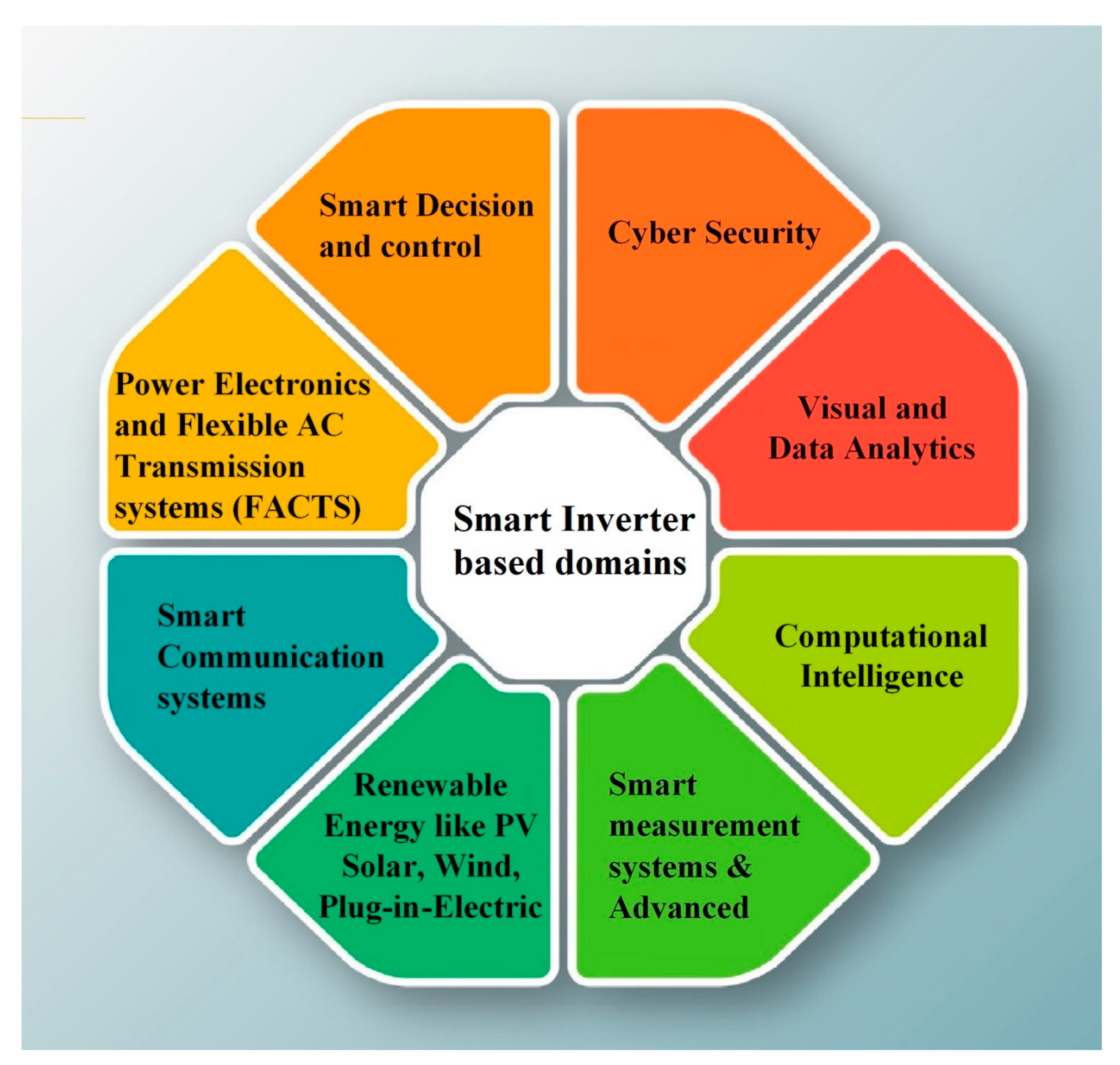





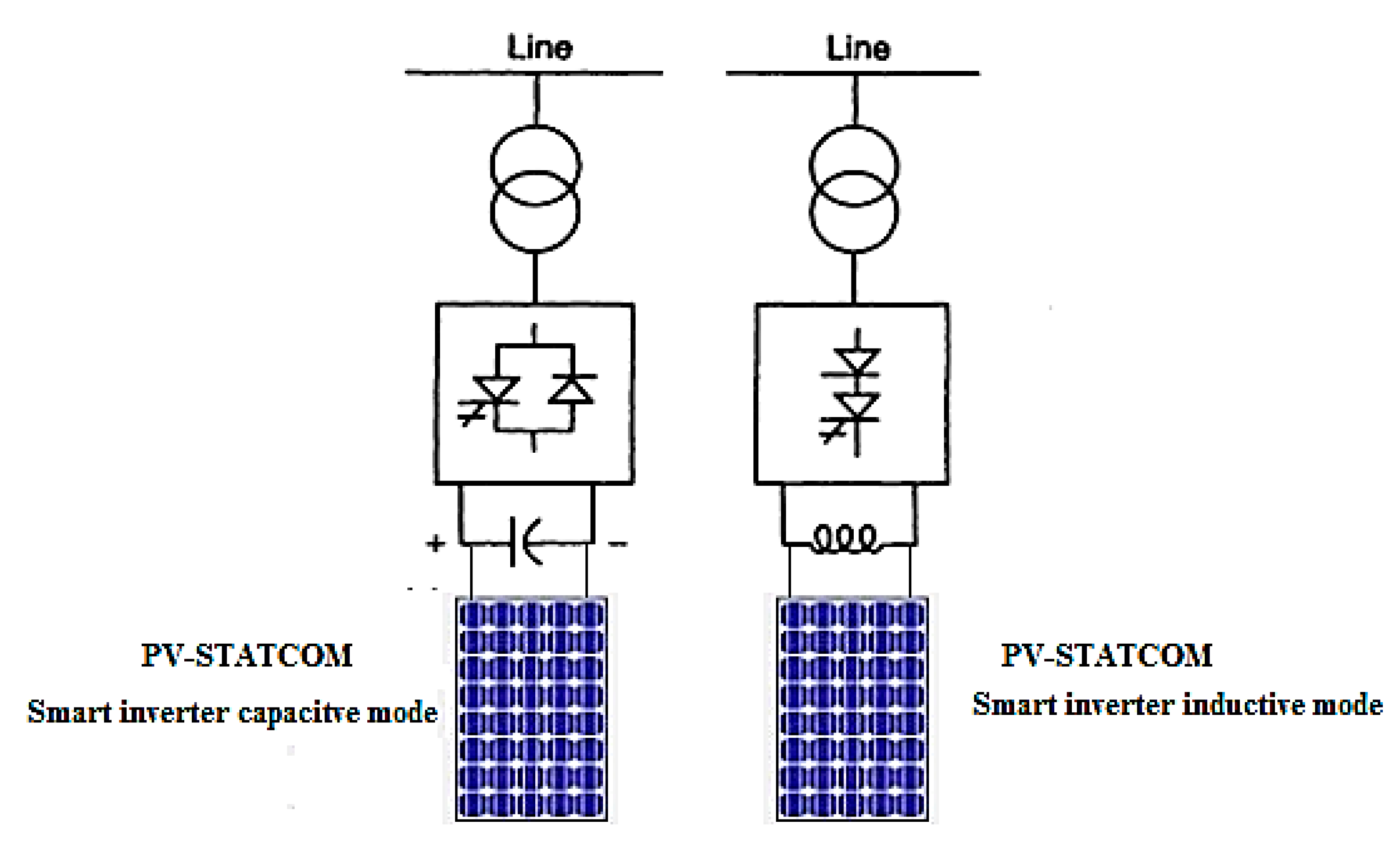








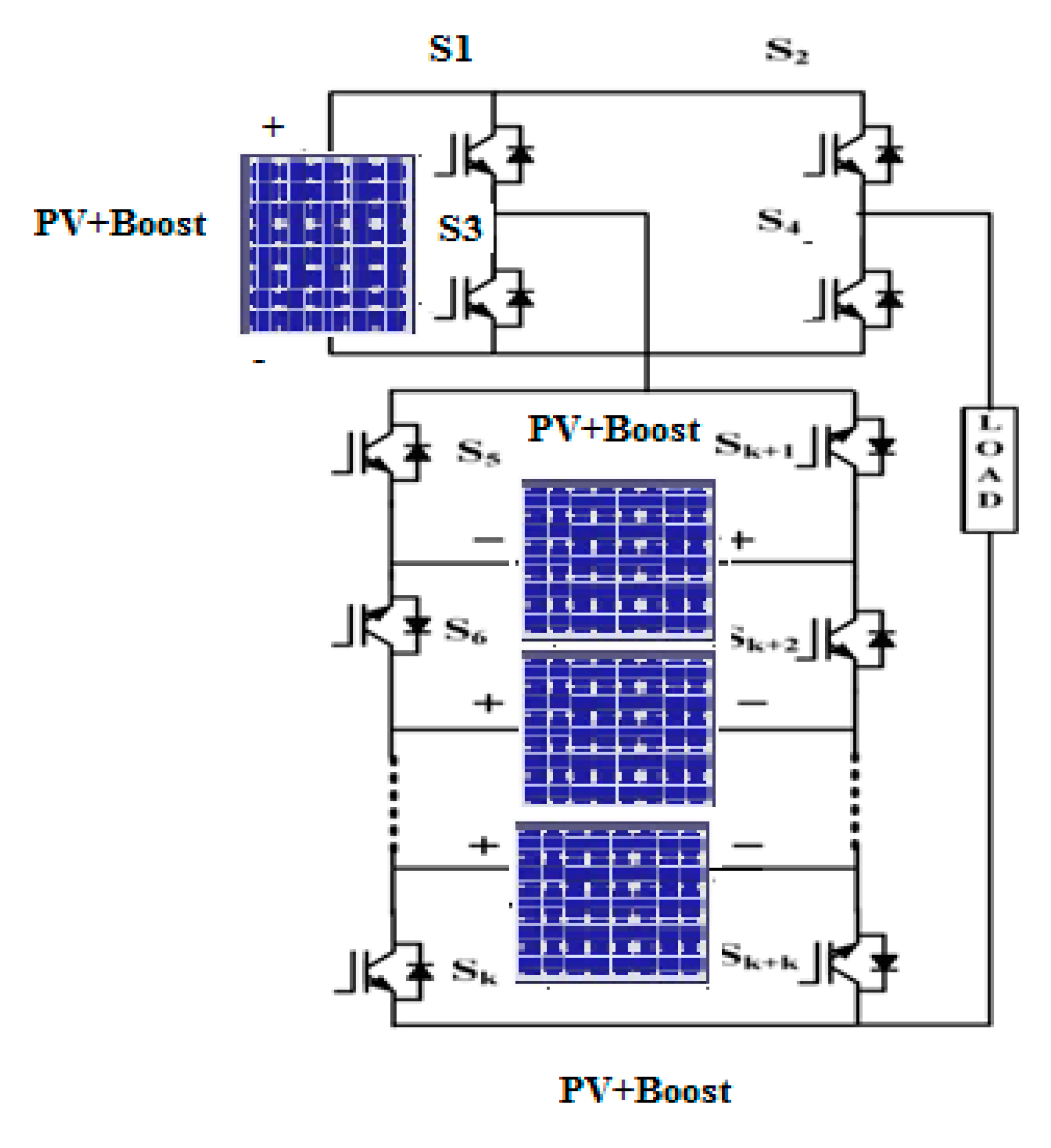
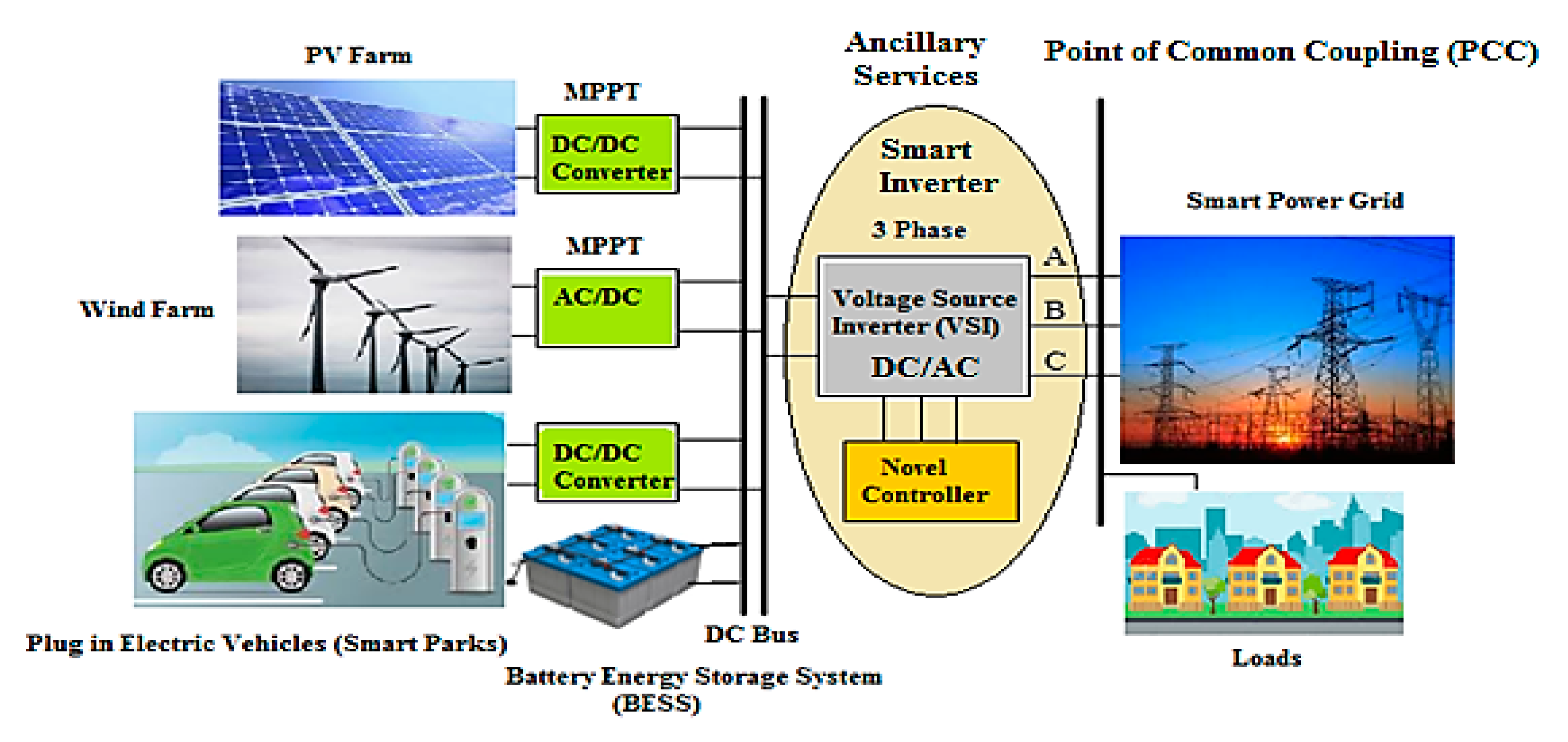
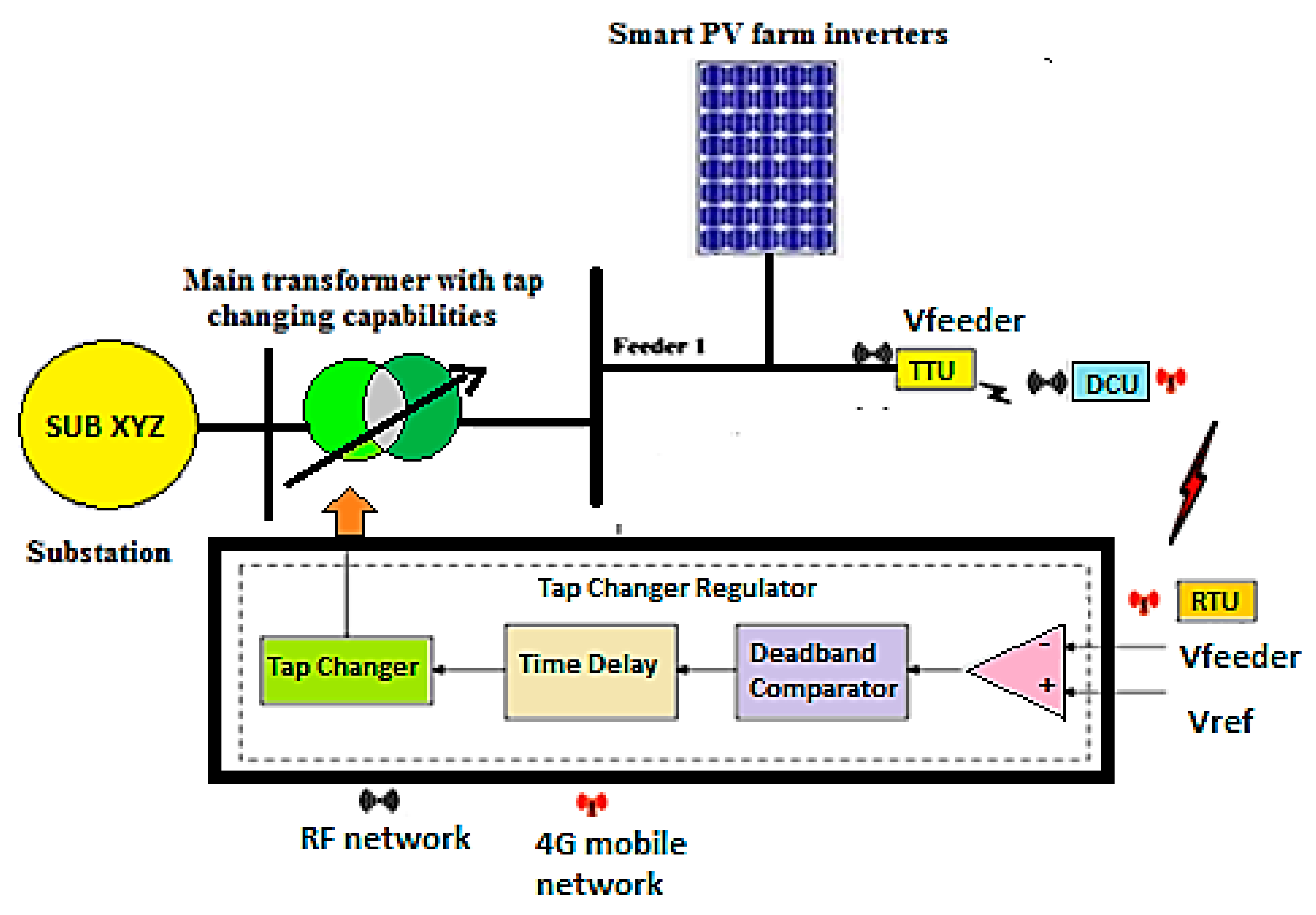
| Situation | Conventional Voltage Source Inverter (VSI) | Smart/Intelligent Hybrid Inverters |
|---|---|---|
| Active Power filtering | Not implemented | Smart inverters with specialized controller can perform active power filtering. |
| Flicker | Not implemented | Voltage and frequency flicker could be mitigated. |
| Voltage/Frequency regulation | Conventional VSIs were disconnected during abnormalities. | Smart inverters can perform the voltage and frequency regulation in the system. |
| Ride through capability | VSIs usually had to disconnect from the system and didn’t have the capability of LVRT/ZVRT or HVRT | Smart inverters could provide VAR support during such an event; thereby they could stay connected with the system by performing the ride through action. |
| Line losses | Conventional VSIs were not configured to inject or absorb VARs. | With the introduction of IEEE 1547.8 and UL 1741 standard, smart inverters were capable of injecting and absorbing VARs in the system. Due to this action, line losses could be reduced to a great extent. |
| Voltage regulation and power factor correction | Conventional VSIs were not equipped with voltage regulation and power factor correction capabilities. | Smart inverters with specialized controllers could perform voltage regulation in the system and power factor correction of local loads thereby serving an effective solution for avoiding penalty from the utility. |
| Virtual detuning | Conventional VSIs were not used for virtual detuning. | With specialized controllers, smart inverters could perform virtual detuning, thereby mitigating network harmonic resonance phenomenon. The harmonics could also be mitigated using this action. |
| Temporary OverVoltage (TOV) mitigation | Conventional VSIs were not used for TOV mitigation | Smart inverters can effectively be used for TOV mitigation in the healthy phases during Single Line to Ground Fault and Double Line to Ground fault. |
| Anti-island detection | Not implemented | Can investigate transient faults based on the scheme that was defined. |
| Reverse power flow | Could not curtail the reverse power flow. | Smart inverters could curtail the voltage rise due to reverse power flow caused from DERs by performing voltage regulation on the system. This also facilitated the increased penetration of DERs like wind, PV, plug-in electric vehicles (PEVs). |
| Power generation | Real power generation alone was possible by making the conventional VSIs to operate at a unity power factor. | Real power generation is possible. Apart from that, the underutilized capacity of the inverter could be utilized for reactive power generation/absorption for ancillary services. |
| Power system restoration | Conventional VSIs were not used for black start purpose and throughout the involvement of power system restoration. | Smart inverters with the real and reactive power supporting capabilities can provide the cranking power for the black start purpose and aid in power system restoration by maintaining the VAR levels. |
| Increase in power transfer capability | Conventional VSIs were not used for this purpose. | Smart inverters can be effectively be installed at the midpoint of a line for performing a suitable shunt compensation like a STATCOM for enhancing the power transfer capability of a line. As a result, more DERs could be integrated into the system with the enhanced capacity within the thermal limits. This also brings in lots of monetary benefits without having to install a new line for power transmission. |
| Subsynchronous resonance (SSR) | Conventional inverters didn’t have such a feature. | Smart inverters with specialized controlled can mitigate subsynchronous resonance (SSR) phenomenon. Most of the functionalities of a STATCOM could be performed by smart inverters. |
© 2020 by the authors. Licensee MDPI, Basel, Switzerland. This article is an open access article distributed under the terms and conditions of the Creative Commons Attribution (CC BY) license (http://creativecommons.org/licenses/by/4.0/).
Share and Cite
Srinivasarangan Rangarajan, S.; Sharma, J.; Sundarabalan, C.K. Novel Exertion of Intelligent Static Compensator Based Smart Inverters for Ancillary Services in a Distribution Utility Network-Review. Electronics 2020, 9, 662. https://doi.org/10.3390/electronics9040662
Srinivasarangan Rangarajan S, Sharma J, Sundarabalan CK. Novel Exertion of Intelligent Static Compensator Based Smart Inverters for Ancillary Services in a Distribution Utility Network-Review. Electronics. 2020; 9(4):662. https://doi.org/10.3390/electronics9040662
Chicago/Turabian StyleSrinivasarangan Rangarajan, Shriram, Jayant Sharma, and C. K. Sundarabalan. 2020. "Novel Exertion of Intelligent Static Compensator Based Smart Inverters for Ancillary Services in a Distribution Utility Network-Review" Electronics 9, no. 4: 662. https://doi.org/10.3390/electronics9040662
APA StyleSrinivasarangan Rangarajan, S., Sharma, J., & Sundarabalan, C. K. (2020). Novel Exertion of Intelligent Static Compensator Based Smart Inverters for Ancillary Services in a Distribution Utility Network-Review. Electronics, 9(4), 662. https://doi.org/10.3390/electronics9040662






